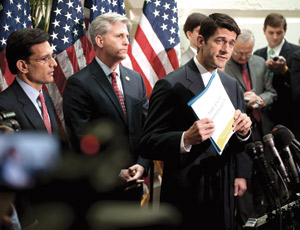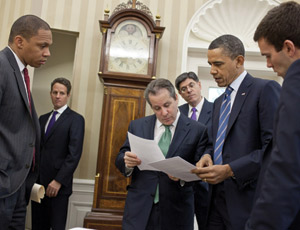The simmering debate over how to cut the federal budget deficit is heating up, with the April 13 release of President Obama's outline for shrinking the budget gap squaring off against House Republicans' deficit-trimming plan, drafted by Budget Committee Chairman Paul Ryan (Wis.) and approved by the chamber on April 15.


Construction officials welcome the fiscal focus. The proposals aim to slash the deficit by about $4 trillion over the next 10 or 12 years and give the economy a lift. Stephen Sandherr, the Associated General Contractors of America's president and CEO, says, “We are in a completely new environment, where for the first time in a long time there is serious attention being brought to bear on the deficit.”
But the Obama and Ryan proposals could squeeze construction in the near term, by slicing hundreds of billions of dollars from domestic programs. Robert A. Murray, McGraw-Hill Construction's vice president for economic affairs, says if aspects of the plans become law, “federal funding restraint will continue to be part of the public-works landscape.”
Both plans target non-defense appropriations, which are just 12% of the overall budget, but 100% of non-military construction funding. Obama seeks to chop non-defense spending $750 billion over 12 years. House Republicans want $1.8 trillion in non-security cuts over 10 years. Sandherr says AGC's message will underline the difference between making key investments and cutting spending.
Obama wants to spare some programs. “I will not sacrifice the core investments that we need to grow and create jobs,” he says, citing clean-energy technology and new roads and airports. Ryan's plan would cut transportation 16% in 2012 and 31% in 2015, compared with the 2011 level.
The plans differ on taxes. The Ryan proposal would cut corporate and individual rates and do away with the 2010 health-care law. Ryan estimates that move would eliminate $800 billion in taxes.
Obama would trim the corporate rate but hike taxes for upper-income taxpayers by letting their 2001 and 2003 tax cuts expire and limiting itemized deductions. That could hit small construction firms set up as partnerships or Subchapter S entities and taxed at individual rates.
Bridging the gulf between the budget plans won't be easy. But Jack Basso, director for program management and finance at the American Association of State Highway and Transportation Officials, believes the two sides will strike a deal. “I don't think they can go into the election [and] have done nothing,” he says. “They've thrown down the gauntlet.”


Post a comment to this article
Report Abusive Comment